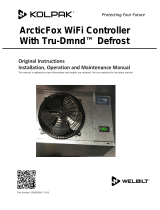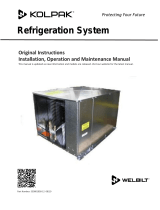Page is loading ...

Installation Guide
Clean Installation
Best Practice
© Danfoss | DCS (mwa) | 2018.11
AN27894255219501-000101 | 1
ENGLISH
Specifications to the Component Supplier
1. All pipes shall be cleaned inside with dry air to remove residues after production and capped on both
ends.
2. Optionally primed on outer surface (batch number shall still be visible).
3. Main components should be cleaned and dried inside after pressure test and delivered sealed and
slightly pressurized with inert gas.
4. Refrigerant should have a controlled water content following local recommendations or requirements
and not higher than below.
R717 HFC HCFC CO₂
<0.5% <60 ppm <30 ppm <15 ppm
Instructions to the Fitter
1. Disassemble the valve top and clean, lubricate (e.g. with refrigerant oil), protect sealing parts and
store in a clean/dry place.
2. Use only pipes that are still capped and clean.
3. Remove metal burrs after drilling and grinding, e.g. using air and/or a magnet.
4. Cap any open pipe ends and don’t leave any tool cloths, cigarettes, tools etc. inside the pipes.
5. Clean and lubricate valve housing sealing surfaces (e.g. with refrigerant oil) and protect openings
against rain and dust, e.g. with plastic.
Instructions to the Welder
1. Always use TIG / Argon welding as the root run, to avoid slag and debris entering the valve house.
2. Complete the welding process according to local legal requirements.
3. Inspect the inside around the welding and remove all debris.
Instructions to the Installer
1. Clean the pipes and valve houses with dry air (no water, no sandblasting).
2. Lubricate valve housing sealing surfaces (e.g. with refrigerant oil).
3. Follow the valve installation instructions.
4. Pressure test the system with dry air or inert gas (no water).
Instructions to the Supervisor
1. Build up the system in sections. For example, have valve trains or valve stations pre-manufactured
before being shipped on site, or make it in a separate clean workshop on site, where welding and
cleaning procedures can be easily controlled.
2. Evacuate the sections to verify that there is no water left in the system.
3. Seal and pressurize finished sections slightly with inert gas.
4. Evacuate down to 5-10 mbar before charging refrigerant.
5. Run free and clean filters frequently for 24-48 hours.
/

